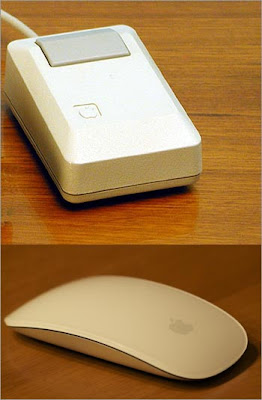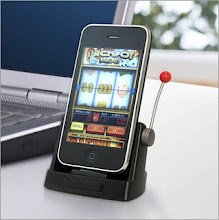Design is an instinct. Its full expression might be realized with training, but for those born with it, it’s inherent in everything they do. Steve Jobs was born a designer.
He intuited its elemental truth: “Design is the fundamental soul of a human-made creation that ends up expressing itself in successive outer layers of the product or service.”
Jobs didn't do it alone. Frog Design, Ideo, and Senior Vice President of Industrial Design at Apple Jonathan Ive lay claim to designs that have become synonymous with Apple, but they all worked under Jobs’ guidance.
Jobs’ gift received little nurturing beyond a calligraphy class he took at Reed College. Yet even that little bit was enough to influence so much of not just his world, but ours. In the prescient, wise, and now oft-quoted commencement address he gave at Stanford University in 2005, he said: "I learned about serif and sans serif typefaces, about varying the amount of space between different letter combinations, about what makes great typography great. It was beautiful, historical, artistically subtle in a way that science can't capture, and I found it fascinating."
For an Esquire story that named Jobs one of the 75 most influential people of the 21st century, the artist and designer Dominic Wilcox created a piece called “The Immaculate Threads.” The Jobsian uniform—jeans, a black turtleneck, and nearly invisible wireframe glasses—is packaged in the iconic Apple acrylic display case and placed on a conveyor belt. It’s a tweak on the idea that Jobs’ essence could be produced, packaged, and distributed like so many Apple products. But we know that while his ideas could be packaged, the spirit of Jobs himself could not.
Here are the ways Jobs gifted the design world.
Jobs didn't do it alone. Frog Design, Ideo, and Senior Vice President of Industrial Design at Apple Jonathan Ive lay claim to designs that have become synonymous with Apple, but they all worked under Jobs’ guidance.
Jobs’ gift received little nurturing beyond a calligraphy class he took at Reed College. Yet even that little bit was enough to influence so much of not just his world, but ours. In the prescient, wise, and now oft-quoted commencement address he gave at Stanford University in 2005, he said: "I learned about serif and sans serif typefaces, about varying the amount of space between different letter combinations, about what makes great typography great. It was beautiful, historical, artistically subtle in a way that science can't capture, and I found it fascinating."
For an Esquire story that named Jobs one of the 75 most influential people of the 21st century, the artist and designer Dominic Wilcox created a piece called “The Immaculate Threads.” The Jobsian uniform—jeans, a black turtleneck, and nearly invisible wireframe glasses—is packaged in the iconic Apple acrylic display case and placed on a conveyor belt. It’s a tweak on the idea that Jobs’ essence could be produced, packaged, and distributed like so many Apple products. But we know that while his ideas could be packaged, the spirit of Jobs himself could not.
Here are the ways Jobs gifted the design world.
Atari Breakout
The first Jobs and Steve Wozniak collaboration that netted them income was not the Apple I, but the Atari arcade game Breakout, the predecessor of BlackBerry’s smash hit Brick Breaker. In 1975, Atari employee Jobs was assigned to build a prototype and paid $750, with a bonus of $100 for each chip eliminated from the design. Jobs enlisted his friend, Hewlett-Packard employee Wozniak, to help him finish it in four days. Sleepless for the next four days, Woz succeeded in eliminating 50 chips from Jobs’ prototype. Atari said the design was difficult to manufacture and ended up designing its own version. All was not lost, though. Wozniak incorporated some of his Breakout work into one of the earliest creations of the company he started with his old friend. Color, sound, and game paddles made their way into the Apple II because of Breakout.
Macintosh Mouse
The story goes that the mouse was an idea Jobs kidnapped from Xerox PARC. On a 1979 trip to the research and development campus, he was shown the Xerox Alto computer and became enchanted by how its mouse eliminated the need for key commands. In a piece for The New Yorker, Malcolm Gladwell documented Ideo co-founder Dean Hovey’s recounting of his subsequent meeting with Jobs: “So he explains it, and he says, ‘You know, [the Xerox mouse] is a mouse that cost three hundred dollars to build and it breaks within two weeks. Here’s your design spec: Our mouse needs to be manufacturable for less than fifteen bucks. It needs to not fail for a couple of years, and I want to be able to use it on Formica and my blue jeans.’” Jobs also insisted that Apple’s mouse had just one button to Xerox’s three, epitomizing his famous distaste for buttons As Gladwell said “[t]he difference…is not trivial. It is the difference between something intended for experts, which is what Xerox PARC had in mind, and something that’s appropriate for a mass audience, which is what Apple had in mind. PARC was building a personal computer. Apple wanted to build a popular computer.” Thirty years later the Magic Mouse appeared, buttonless and multi-touch.
iMac
Apple’s years without Steve Jobs were hard ones. The company was nearly bankrupt and its products lacked innovation. When he returned, Jobs dramatically stripped the Apple inventory down to just the Power Macintosh G3 series. Then for his comeback, he introduced one that was alien and familiar all at once, the iMac. The work of Ive under the close direction of Jobs, the iMac was a rotund mix of Bondi blue and translucent plastic with a matching circular mouse attached. Its cheery appearance heralded the return of good fortune for the company.
Power Mac G4 Cube
The Power Mac G4 Cube lasted just a year on the market but lives on at MoMA, the Design Museum, in movies, and in living rooms. The Cube garnered PCMag’s respect, coming in as a finalist in The Seventeenth Annual Technical Excellence Awards. “Apple has raised the design bar yet again,” we said. The Cube’s workings hover in a crystal-clear case, convection cooling keeps it quiet, Harman Kardon speakers serve as attendant beauties, and just one cable manages power, video, and USB. The Cube bears the markings of a Jobs creation, sharing its shape with the NeXTcube from Jobs’ years away from Apple.
Packaging
Jobs knew the art of presentation and carried it through to the unboxing of products. His name is on patents for several of the acrylic boxes that encase Apple goods. Cult of Mac includes this in its hero worship: “All of Jobs’s products have been carefully packaged going back to the original Mac in 1984. Jobs believes unpacking a product is a great way to introduce unfamiliar technology to the consumer— they explore the components as they unbox them.”
iPod
The invention of the wheel undoubtedly got a lot of hype in its time, but not nearly as much as the invention of the clickwheel. MP3 players were already plentiful when the iPod was introduced but none of them so naturally connected listeners to their music. Other devices relied on thick manuals for their owners to understand them while iPods came accompanied by nothing more than a flimsy pamphlet.
Apple Stores
If there truly were a stairway to heaven, it would look like the one in an Apple store. The stores themselves are minimalist marvels but it’s the stairs that are the showstoppers. The airy staircases and their glass support members each have their own patents, with Steve Jobs’ name listed first on them. The feats of engineering are carried out by Eckersley O’Callaghan Structural Design. While the frosted horizontal slices look delicate, the glass is made to withstand even seismic shifts.
iPhone
With the iPhone, Jobs served up the Internet, bento-box-style, with apps. It was deconstructed, categorized, and made portable. When it’s off, the iPhone is an enigmatic black slab, but when it’s on, there’s little that it’s not. Its design became the inspiration for many, as the subsequent patent wars proved.
MacBook Air
Journalist Steven Levy’s account of losing a MacBook Air he was lent to review validated what it accomplished. In his own defense, Levy said in Newsweek: “When something is thin enough to fit into an envelope, light enough to sit on your lap for a couple of hours without discomfort and so compact that it doesn't even bulge in an airline seat-back pocket, wouldn't it make sense that one could lose track of such a thing? Even if it is a computer?” The MacBook Air has inspired an entire category of laptops—ultrabooks—to spring up around the same form factor. When the topic of ultrabooks comes up, the question is often asked: Is the MacBook Air an ultrabook? It is, but the equation can’t be reversed.
iPad
The iPad was not always the most popular kid on the tablet playground. People made fun of its name, its size, and its smarts. But like any parent of a bullied child, Apple encouraged the iPad’s persistence. By the time the iPad 2 came out, Apple could say: “Now, we can watch a newspaper; listen to a magazine; curl up with a movie; and see a phone call. Now, we can take a classroom anywhere; hold an entire bookstore; and touch the stars. Because now, there’s this.
Apple TV GUI
The set-top box market continues to languish but Apple nevertheless released a second generation of its Apple TV and has added content. Steve Jobs shares the patent for the interface that lets consumers stream and watch iTunes, Netflix, Vimeo, and other Internet content on their TVs.
Headquarters
Just three months ago, Jobs unveiled the largest and most futuristic design he has worked on: the plans for a new Apple headquarters. A circle within a circle, the building resembles nothing so much as the spaceships of our collective consciousness. Designed by the icon-producing architecture firm Norman Foster and Partners, the building is of the unmistakable Jobs aesthetic. Just as Apple devices had to have as few buttons as possible, the headquarters’ design appears to lack doors or window frames. "There's not a straight piece of glass in this building—it's all curved," Jobs said. "We know how to build the biggest pieces of glass for architectural use." While the building will be new, it will remain in Cupertino, the place where Jobs was raised.



























0 comments:
Post a Comment